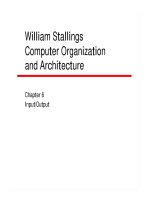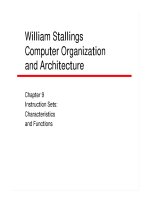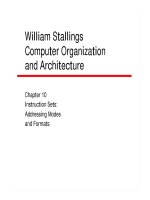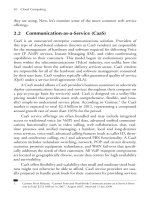Computer Organization and Architecture phần 3 potx
Bạn đang xem bản rút gọn của tài liệu. Xem và tải ngay bản đầy đủ của tài liệu tại đây (496.73 KB, 10 trang )
21
Universidade do Minho – Dep. Informática - Campus de Gualtar – 4710-057 Braga - PORTUGAL-
William Stallings, “Computer Organization and Architecture”, 5th Ed., 2000
bytes). The initiator also asserts IRDY to indicated that it is ready for the first data
item.
d. The selected target asserts DEVSEL to indicate that it has recognized its address and
will respond. It places the requested data on the AD lines and asserts TRDY to
indicate that valid data is present on the bus.
e. The initiator reads the data at the beginning of clock 4 and changes the byte enable
lines as needed in preparation for the next read.
f. In this example, the target needs some time to prepare the second block of data for
transmission. Therefore, it deasserts TRDY to signal the initiator that there will not be
new data during the coming cycle. Accordingly, the initiator does not read the data
lines at the beginning of the 5th clock cycle and does not change byte enable during
that cycle. The block of data is read at beginning of clock 6.
g. During clock 6, the target places the 3rd data item on the bus. However, in this
example, the initiator is not yet ready to read the data item (e.g., it has a temporary
buffer full condition). It therefore deasserts IRDY. This will cause the target to maintain
the third data item on the bus for an extra clock cycle.
h. The initiator knows that the 3rd data transfer is the last, and so it deasserts FRAME to
signal the target that this is the last data transfer. It also asserts IRDY to signal that it
is ready to complete that transfer.
i. The initiator deasserts IRDY, returning the bus to the idle state, and the target
deasserts TRDY and DEVSEL.
• Arbitration
o Centralized
o Synchronous
o Each master has a unique request (REQ) and grant (GNT) signal
o Each master’s REQ and GNT is attached to a central arbiter
o Arbitration algorithm can be any desired, programmed into the arbiter
o Uses hidden arbitration, meaning that arbitration can take place while other bus
transactions are occurring on other bus lines
PCI Enhancements: AGP
• AGP – Advanced Graphics Port
o Called a port, not a bus because it only connects 2 devices
22
Universidade do Minho – Dep. Informática - Campus de Gualtar – 4710-057 Braga - PORTUGAL-
William Stallings, “Computer Organization and Architecture”, 5th Ed., 2000
II. THE COMPUTER SYSTEM.
3.
4. Internal Memory. (29-Feb-00)
Characteristics of Computer Memory Systems (4.1)
• Location
o CPU (registers and L1 cache)
o Internal Memory (main)
o External (secondary)
• Capacity
o Word Size - typically equal to the number of bits used to represent a number and to
the instruction length.
o Number of Words - has to do with the number of addressable units (which are
typically words, but are sometimes bytes, regardless of word size). For addresses of
length A (in bits), the number of addressable units is 2A.
• Unit of Transfer
o Word
o Block
• Access Method
o Sequential Access
§ information used to separate or identify records is stored with the records
§ access must be made in a specific linear sequence
§ the time to access an arbitrary record is highly variable
o Direct Access
§ individual blocks or records have an address based on physical location
§ access is by direct access to general vicinity of desired information, then
some search
§ access time is still variable, but not as much as sequential access
o Random Access
§ each addressable location has a unique, physical location
§ access is by direct access to desired location
§ access time is constant and independent of prior accesses
o Associative
§ desired units of information are retrieved by comparing a sub-part of the unit
with a desired mask location is not needed
§ all matches to the mask are retrieved simultaneously
§ access time is constant and independent of prior accesses
§ most useful for searching - a search through N possible locations would take
O(N) with Random Access Memory, but O(1) with Associative Memory
• Performance
o Access Time
o Memory Cycle Time - primarily for random-access memory = access time + additional
time required before a second access can begin (refresh time, for example)
o Transfer Rate
§ Generally measured in bits/second
23
Universidade do Minho – Dep. Informática - Campus de Gualtar – 4710-057 Braga - PORTUGAL-
William Stallings, “Computer Organization and Architecture”, 5th Ed., 2000
§ Inversely proportional to memory cycle time for random access memory
• Physical Type
o Most common - semiconductor and magnetic surface memories
o Others - optical, bubble, mechanical (e.g. paper tape), core, esoteric/theoretical (e.g.
biological)
• Physical Characteristics
o volatile - information decays or is lost when power is lost
o non-volatile - information remains without deterioration until changed no electrical
power needed
o non-erasable
§ information cannot be altered with a normal memory access cycle
§ As a practical matter, must be non-volatile
• Organization - the physical arrangement of bits to form words.
o Obvious arrangement not always used
o Ex. Characters vs. Integers vs. Floating Point Numbers
The Memory Hierarchy
• Design Constraints
o How much? “If you build it, they will come.” Applications tend to be built to use any
commonly available amount, so question is open-ended.
o How fast? Must be able to keep up with the CPU don’t want to waste cycles waiting
for instructions or operands.
o How expensive? Cost of memory (also associated with “How much?”) must be
reasonable vs. other component costs.
• There are trade-offs between the 3 key characteristics of memory (cost, capacity, and access
time) which yield the following relationships:
o Smaller access time -> greater cost per bit
o Greater capacity -> smaller cost per bit
o Greater capacity -> greater access time
• The designer’s dilemma
o Would like to use cheaper, large capacity memory technologies
o Good performance requires expensive, lower-capacity, quick-access memories
• Solution: Don’t rely on a single memory component or technology use a memory hierarchy
o Organizes memories such that:
§ Cost/bit decreases
§ Capacity increases
§ Access time increases
o Data and instructions are distributed across this memory according to:
§ Frequency of access of the memory by the CPU decreases (key to success)
o This scheme will reduced overall costs while maintaining a given level of performance.
• Contemporary Memory Hierarchy
Magnetic Tape
Optical/Magnetic Disk
Disk Cache
Main Memory
Cache
Registers
24
Universidade do Minho – Dep. Informática - Campus de Gualtar – 4710-057 Braga - PORTUGAL-
William Stallings, “Computer Organization and Architecture”, 5th Ed., 2000
• Success depends upon the locality of reference principle
o memory references tend to cluster
§ temporal locality - if a location is referenced, it is likely to be referenced again
in the near future
§ positional locality - when a location is referenced, it is probably close to the
last location referenced
o so a single (slower) transfer of memory from a lower level of the hierarchy to a higher
level of the hierarchy will tend to service a disproportionate number of future requests,
which can be satisfied by the higher (faster) level
o This is the technique which is the basis for caching and virtual memory
o Although we don’t always refer to it as caching, this technique is used at all levels of
the memory hierarchy, often supported at the operating system level
Semiconductor Main Memory (4.2)
• Types of Random-Access Semiconductor Memory
o RAM - Random Access Memory
§ misused term (all these are random access)
§ possible both to read data from the memory and to easily and rapidly write
new data into the memory
§ volatile - can only be used for temporary storage (all the other types of
random-access memory are non-volatile)
§ types:
§ dynamic - stores data as charge on capacitors
§ tend to discharge over time
§ require periodic charge (like a memory reference) to refresh
§ more dense and less expensive than comparable static
RAMs
§ static - stores data in traditional flip-flop logic gates
§ no refresh needed
§ generally faster than dynamic RAMs
o ROM - Read Only Memory
§ contains a permanent pattern of data which cannot be changed
§ data is actually wired-in to the chip as part of the fabrication process
§ data insertion step has a large fixed cost
§ no room for error
§ cheaper for high-volume production
o PROM - Programmable Read Only Memory
§ writing process is performed electrically
§ may be written after chip fabrication
§ writing uses different electronics than normal memory writes
§ no room for error
§ attractive for smaller production runs
o EPROM - Erasable Programmable Read Only Memory
§ read and written electrically, as with PROM
§ before a write, all cells must be erased by exposure to UV radiation (erasure
takes about 20 minutes)
§ writing uses different electronics than normal memory writes
§ errors can be corrected by erasing and starting over
§ more expensive than PROM
o EEPROM - Electrically Erasable Programmable Read Only Memory
§ byte-level writing - any part(s) of the memory can be written at any time
§ updateable in place - writing uses ordinary bus control, address, and data
lines
25
Universidade do Minho – Dep. Informática - Campus de Gualtar – 4710-057 Braga - PORTUGAL-
William Stallings, “Computer Organization and Architecture”, 5th Ed., 2000
§ writing takes much longer than reading
§ more expensive (per bit) and less dense than EPROM
o Flash Memory
§ uses electrical erasing technology
§ allows individual blocks to be erased, but not byte-level erasure, and modern
flash memory is updateable in place (some may function more like I/O
modules)
§ much faster erasure than EPROM
§ same density as EPROM
§ sometimes refers to other devices, such as battery-backed RAM and tiny
hard-disk drives which behave like flash memory for all intents and purposes
• Organization
o All semiconductor memory cells:
§ exhibit 2 stable (or semi-stable states) which can represent binary 1 or 0
§ are capable of being written into (at least once), to set the state
§ are capable of being read to sense the state
o Commonly, a cell has 3 functional terminals capable of carrying an electrical signal
• Chip Logic
o Number of bits that can be read/written at a time
§ Physical organization is same as logical organization is one extreme (W
words of B bits each)
§ Other extreme is 1-bit-per-chip data is read/written one bit at a time
o Typical organization
§ 4 bits read/written at a time
§ Logically 4 square arrays of 2048x2048 cells
§ Horizontal lines connect to Select terminals
§ Vertical lines connect to Data-In/Sense terminals
§ Multiple DRAMs must connect to memory controller to read/write an 8 bit
word
§ Illustrates why successive generations grow by a factor of 4 each extra pin
devoted to addressing doubles the number of rows and columns
26
Universidade do Minho – Dep. Informática - Campus de Gualtar – 4710-057 Braga - PORTUGAL-
William Stallings, “Computer Organization and Architecture”, 5th Ed., 2000
• Chip Packaging
o Typical Pin outs
§ A0-An: Address of word being accessed (may be multiplexed row/column) for
an n bit (n*2 bit) address
§ D0-Dn: Data in/out for n bits
§ Vcc: Power supply
§ Vss: Ground
§ CE: Chip enable - allows several chips to use same circuits for everything
else, but only have one chip use them
§ Vpp: Program Voltage - used for writes to (programming) an EPROM
§ RAS: Row Address Select
§ CAS: Column Address Select
§ W or WE: Write enable
§ OE: Output enable
• Error Correction Principles
o Hard Failure
§ a permanent defect
§ causes same result all the time, or randomly fluctuating results
o Soft Error - a random, nondestructive event that alters the contents of one or more
memory cells, without damaging the memory. Caused by:
§ power supply problems
§ alpha particles
o Detection and Correction
• Hamming codes
o An error-correcting code are characterized by the number of bit errors in a word that it
can correct and detect
o The Hamming Code is the simplest error-correcting code. For example, a hamming
code for 4 data bits (1110) requires 3 parity bits (100), as shown (to make number of
1’s in a circle even): Note that the parity bits (10) are now incorrect, and their
intersection identifies the data bit in error, which can be corrected back to (1) by
negation.
• SEC-DED (single-error-correcting, double-error-detecting) codes
o Note that an error of more than a single bit cannot be corrected with the previous
method (called a single-error-correcting code).
o Instead, we can add an additional bit to make the total number of 1’s (in both data and
parity bits) even. If this bit compares differently, we know that a double error has been
detected (although we cannot correct it)
Cache Memory (4.3)
• Principles
o Intended to give memory speed approaching that of fastest memories available but
with large size, at close to price of slower memories
o Cache is checked first for all memory references.
o If not found, the entire block in which that reference resides in main memory is stored
in a cache slot, called a line
o Each line includes a tag (usually a portion of the main memory address) which
identifies which particular block is being stored
o Locality of reference implies that future references will likely come from this block of
memory, so that cache line will probably be utilized repeatedly.
27
Universidade do Minho – Dep. Informática - Campus de Gualtar – 4710-057 Braga - PORTUGAL-
William Stallings, “Computer Organization and Architecture”, 5th Ed., 2000
o The proportion of memory references, which are found already stored in cache, is
called the hit ratio.
• Elements of Cache Design
o Cache Size
§ small enough that overall average cost/bit is close to that of main memory
alone
§ large enough so that overall average access time is close to that of cache
alone
§ large caches tend to be slightly slower than small ones
§ available chip and board area is a limitation
§ studies indicate that 1K-512K words is optimum cache size
• Mapping Function - determining which cache line to use for a particular block of main memory
(since number_of_cache_lines << number_of_blocks)
o Direct mapping: line# = block# modulo number_of_cache_lines
§ each block of main memory gets a unique mapping
§ if a program happens to repeatedly reference words from two different blocks
that map into the same cache line, then the blocks will be continually swapped
in the cache and the hit ratio will be low.
28
Universidade do Minho – Dep. Informática - Campus de Gualtar – 4710-057 Braga - PORTUGAL-
William Stallings, “Computer Organization and Architecture”, 5th Ed., 2000
Note that
§ all locations in a single block of memory have the same higher order bits (call
them the block number), so the lower order bits can be used to find a
particular word in the block.
§ within those higher-order bits, their lower-order bits obey the modulo mapping
given above (assuming that the number of cache lines is a power of 2), so
they can be used to get the cache line for that block
§ the remaining bits of the block number become a tag, stored with each cache
line, and used to distinguish one block from another that could fit into that
same cache line.
o Associative Mapping
§ Allows each memory block to be loaded into any line of the cache
§ Tag uniquely identifies a block of main memory
§ Cache control logic must simultaneously examine every line’s tag for a match
§ Requires fully associative memory
§ very complex circuitry
§ complexity increases exponentially with size
§ very expensive
o Set Associative Mapping
§ Compromise between direct and associative mappings
§ Cache is divided into v sets, each of which has k lines
§ number_of_cache_lines = vk
§ set# = block# modulo v
§ so a given block will map directly to a particular set, but can occupy
any line in that set (associative mapping is used within the set)
§ the most common set associative mapping is 2 lines per set, and is
called two-way set associative. It significantly improves hit ratio over
direct mapping, and the associative hardware is not too expensive.
29
Universidade do Minho – Dep. Informática - Campus de Gualtar – 4710-057 Braga - PORTUGAL-
William Stallings, “Computer Organization and Architecture”, 5th Ed., 2000
• Replacement Algorithms
o When all lines are occupied, bringing in a new block requires that an existing line be
overwritten
§ No choice possible with direct mapping
§ Algorithms must be implemented in hardware for speed
o Least-recently-used (LRU)
§ Idea: replace that block in the set which has been in cache longest with no
reference to it
§ Implementation: with 2-way set associative, have a USE bit for each line in a
set. When a block is read into cache, use the line whose USE bit is set to 0,
then set its USE bit to one and the other line’s USE bit to 0.
§ Probably the most effective method
o First-in-first-out (FIFO)
§ Idea: replace that block in the set which has been in the cache longest
§ Implementation: use a round-robin or circular buffer technique (keep up with
which slot’s “turn” is next)
o Least-frequently-used (LFU)
§ Idea: replace that block in the set which has experienced the fewest
references
§ Implementation: associate a counter with each slot and increment when used
o Random
§ Idea: replace a random block in the set
§ Interesting because it is only slightly inferior to algorithms based on usage.
• Write Policy
o If a block has been altered in cache, it is necessary to write it back out to main
memory before replacing it with another block (writes are about 15% of memory
references)
30
Universidade do Minho – Dep. Informática - Campus de Gualtar – 4710-057 Braga - PORTUGAL-
William Stallings, “Computer Organization and Architecture”, 5th Ed., 2000
o Problems
§ I/O modules may be able to read/write directly to memory
§ Multiple CPU’s may be attached to the same bus, each with their own cache
o write through
§ all write operations are made to main memory as well as to cache, so main
memory is always valid
§ other CPU’s monitor traffic to main memory to update their caches when
needed
§ this generates substantial memory traffic and may create a bottleneck
o write back
§ when an update occurs, an UPDATE bit associated with that slot is set, so
when the block is replaced it is written back first
§ accesses by I/O modules must occur through the cache
§ multiple caches still can become invalidated, unless some cache coherency
system is used. Such systems include:
§ Bus Watching with Write Through - other caches monitor memory
writes by other caches (using write through) and invalidates their own
cache line if a match
§ Hardware Transparency - additional hardware links multiple caches
so that writes to one cache are made to the others
§ Non-cacheable Memory - only a portion of main memory is shared by
more than one processor, and it is non-cacheable
• Block Size
o As the block size increases, more useful data is brought into the cache, increasing hit
ratio, BUT
o Larger blocks reduce the number of blocks that fit into a cache, and a small number of
blocks results in data being overwritten shortly after it is fetched
o As a block becomes larger, each additional word is farther from the requested word,
therefore less likely to be needed in the near future
o A size from 4 to 8 addressable units seems close to optimum
• Number of Caches
o On-chip cache (L1 cache)
§ on same chip as CPU
§ requires no bus operation for cache hits
§ short data paths and same speed as other CPU transactions
§ reduces overall bus activity and increases not only CPU operations but overall
system performance
o Off-chip cache (L2 cache) may still be desirable
§ It can be much larger
§ It can be used with a local bus to buffer the CPU cache-misses from the
system bus
• Unified vs. Split Cache
o Unified cache
§ a single cache stores both data and instructions
§ has a higher hit rate that split cache, because it automatically balances load
between data and instructions (if an execution pattern involves more
instruction fetches than data fetches, the cache will fill up with more
instructions than data)
§ only one cache need be designed and implemented









